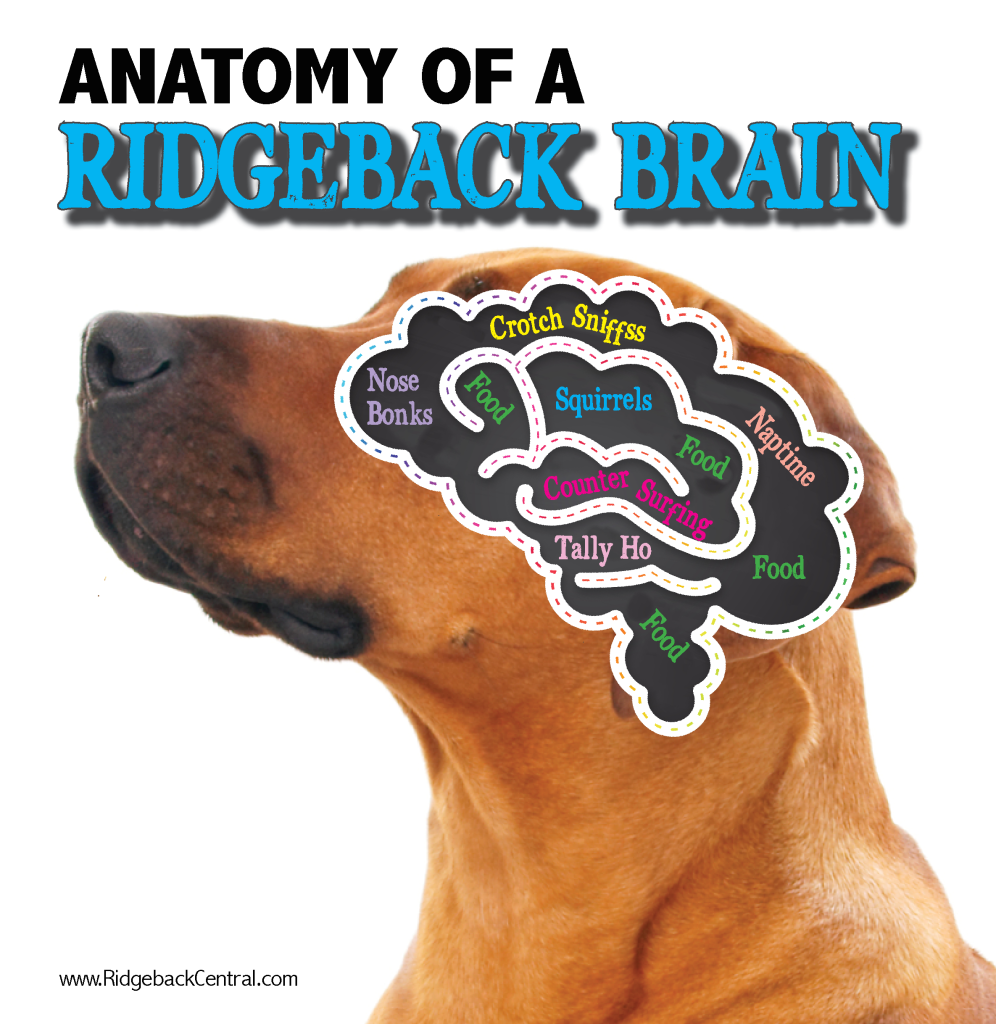What breeds lurk in the Ridgeback’s genes? Now, scientists can tell us.
If you’re a Ridgeback history junkie, prepare to become very, very excited.
Some breeds have the luxury of being founded by compulsive individuals with a knack for documentation. The early Boer architects of the Rhodesian Ridgeback, however, were more interested in shooting their supper and avoiding the rake of a leopard’s claws than noodling with pedigrees or preserving parentage. As a result, we have had a very tentative understanding of what breeds went into making the Rhodesian Ridgeback.
Until now.
Earlier this week, Cell Reports magazine published a paper called “Genomic Analyses Reveal the Influence of Geographic Origin, Migration, and Hybridization on Modern Dog Breed Development.” To create what is the most diverse data set of dog breeds to date, the researchers studied 161 modern breeds, comparing 170,000 different points on their genomes. They identified 23 clades, or breed clusters, containing breeds that are significantly related.
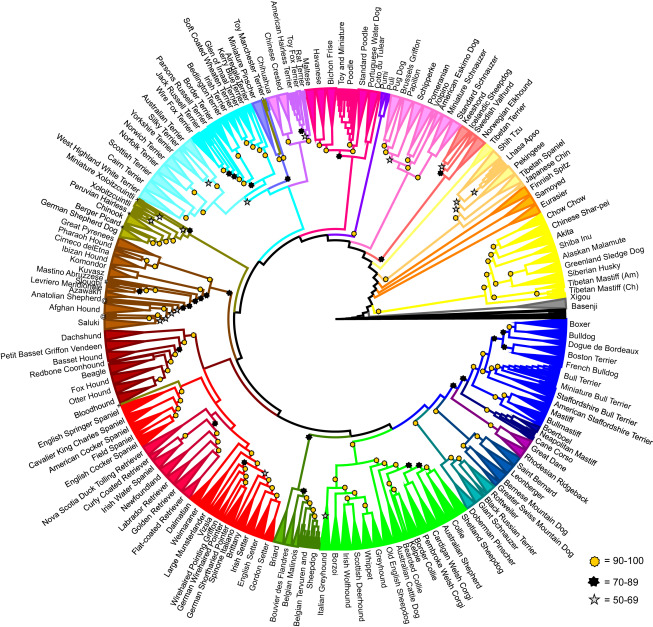
A graphic showing the 23 clades identified by the researchers. Proximity to another clade is not relevant; what matters are the dogs that share the same color, which reflects their shared genetic heritage. Look for the Ridgeback in the hot-pink clade at about positioned at about the four-o’clock mark.
“There are different reasons logically that a breed could be assigned to a clade,” explains one of the paper’s authors, Dr. Dayna Dreger of the National Institutes of Health in Bethesda, Maryland. “Its breeds might be derived from a common source, or it could reflect that there was introgression of one breed into another.”
The scientists assigned the Rhodesian Ridgeback to a clade that has just one other breed:
The Great Dane.
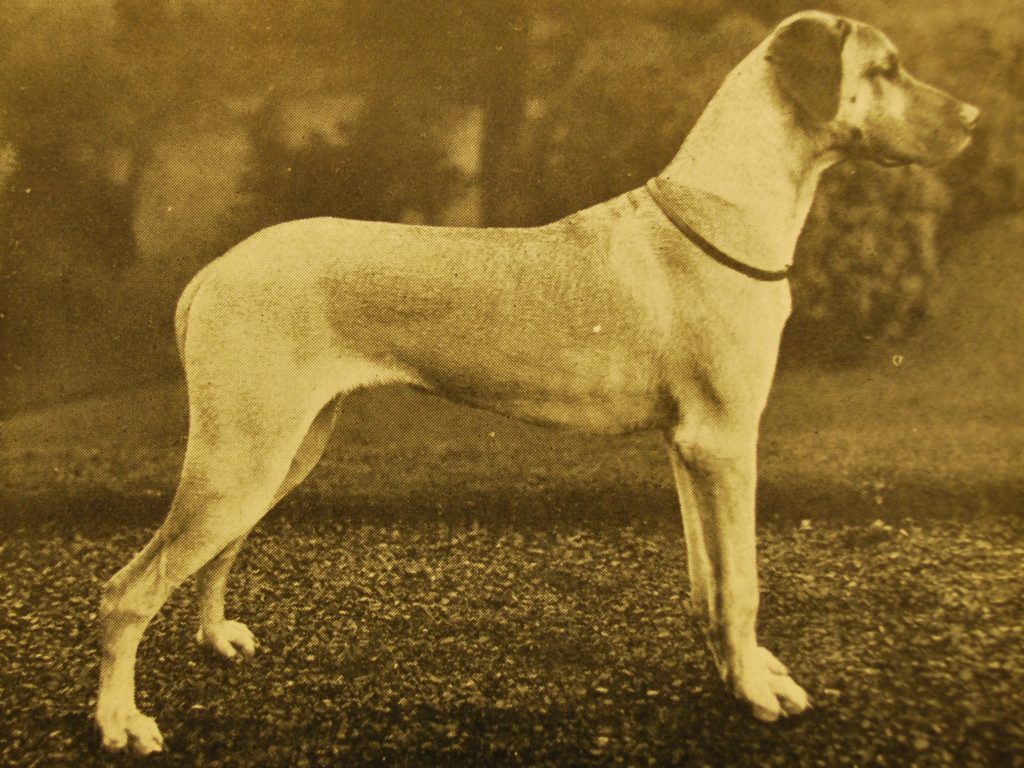
Recruit of Foxbar, a female Great Dane from the 1930s.
If you know your breed history, that canine connection doesn’t come totally out of left field: In her seminal book Rhodesian Ridgeback Pioneers, author Linda Costa shares correspondence from De Beers Ranch officials in Rhodesia in the early 1920s that outlines the diamond mine’s plans to breed Lion Dog sires to recently procured Great Dane bitches. The planned progeny were to be used to hunt vermin on the grounds of the diamond mines, including wild dogs. “I really want rough, big dogs,” one official wrote. ” … the pure Lion Dog appear [sic] too small for the use I need them for in Rhodesia.”
Photographs of Great Danes from the early-20th Century-show dogs that were more moderate in size and type than today’s much more stylized Danes — not too far removed from a modern Ridgeback. And some might argue that Great Dane type is one of the strongest drags on the breed today, manifesting in over-standard size, relative narrowness for that ample height, a squarer silhouette, excessive haw and flews, black masks that extend over the eyes and an overall “extreme” outline.
In addition to grouping breeds into these related clades, the researchers delved into breed make-up. “The paper looked across the admixture of how are breeds created — what was mixed with what to create what,” says Dr. Elaine Ostrander, another of the paper’s authors, who is world famous for her work in purebred-dog genetics.
 At left are the paper’s findings of the significant genetic influences in the Rhodesian Ridgeback.
At left are the paper’s findings of the significant genetic influences in the Rhodesian Ridgeback.
Let’s take a look at some of the historical and geographic evidence we have of these breeds intersecting with the Ridgeback.
I’ve always found it interesting that there is very little cultural exchange between Rhodesian Ridgeback and Boerbel fanciers. In fact, many of the former are unaware that the Molosser-derived Boerboel developed in tandem with the Ridgeback in the same region of Africa. This lack of awareness could stem from the fact that the breeds had different emphases: Both are hunters and guardians, but the Ridgeback specializes in the former and the Boerboel in the latter. Perhaps the Ridgeback’s development to the north, in Rhodesia, further cementing the division between the two breeds, in the dog fancy at least.
At first glance, having the Basenji place so high on the list of Ridgeback-influencing breeds might seem odd, but this wrinkle-browed dog is a native African, so genetically unique that is has its own singular clade in the study. Sheer geography makes it logical that this purely African breed would have found its way into the Ridgeback gene pool, which is otherwise composed of Continental breeds brought to Africa by European colonizers. Dr. Ostrander notes wryly that the impact of one of the Ridgeback’s most important ancestors, the Khoikhoi dog, can’t be assessed because there are no surviving dogs to provide DNA, though a sampling of ridged Africanis dogs might be the next best thing. And those dogs might prove more closely connected to the Basenji themselves.
The rest of the breeds on the researchers’ list of Ridgeback “introgressors” are European. And they dovetail with surprising precision with the list of founding breeds proposed by the late Canadian breeder-judge David Helgesen in his self-published Definitive Rhodesian Ridgeback.
For the 1984 book, Helgesen analyzed period newspapers to determine what breeds were most common in turn-of-the-last-century Rhodesia, when the breed was formally developed by big-game hunter Cornelius van Rooyen. That, paired with anecdotal accounts of van Rooyen’s pack, led to his oft-repeated list of eight foundation breeds: Greyhound (for speed), Bulldog (for substance and biting power), Irish Terrier and Airedale (for tenacity, and, in the case of the Irish, coat color), Collie (for slashing ability), Pointer (for air scenting ability), Deerhound (for size as well as all the Greyhound’s advantages) and of course the Khoikhoi dog, which contributed the ridge, as well as unknown levels of native knowledge, disease resistance and local adaptability. Other than the Khoikhoi dog and the Irish Wolfhound (which is mostly made up of Deerhound blood, with still more Dane thrown in), only the Pointer is missing from the paper’s list of influential breeds in the Ridgeback — the only real stumper I find in these results.

Genome haplotype sharing for the Rhodesian Ridgeback, from “Genomic Analyses Reveal the Influence of Geographic Origin, Migration, and Hybridization on Modern Dog Breed Development.” Labels added by RidgebackCentral.com.
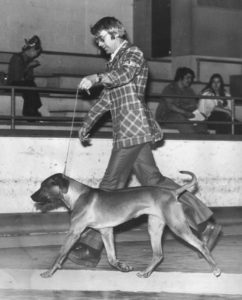
David Helgesen in the ring, 1970s.
Helgesen’s candidates aside, other breeds that come up in the modern DNA findings are logical fits, too. South African diamond mines also used Bullmastiffs for guard and patrol duty, and the Boerboel has a good infusion of Bullmastiff blood itself. Some lines of early Ridgebacks — in particular, Graham Stacey’s Dewsbury and Khami dogs, and those of Phyllis Archdale — had wiry coats accompanied by good size, which strongly evoke the Irish Wolfhound (and so, by extension, the Great Dane), and period articles also mention Wolfhounds being used for lion hunting in Africa. And the occasional black-and-tan has led many Ridgeback fanciers to assume that a two-tone breed — like a Doberman or Rottweiler — jumped the fence somewhere along the line.
In the end, what does all this provide us, other than cocktail-party fodder? For breeders, knowing the Ridgeback’s actual foundation breeds — as well as those that parachuted in later as it developed — helps us chart where our Ridgebacks are heading. Though those who wrote the first Ridgeback standard in 1922 were aiming for a souped-up version of the Dalmatian — that spotted breed’s standard was used to draft the Ridgeback’s, in some places word for word — none of the high-influence breeds in this new genomic study share that basic endurance-trotting silhouette. (Which makes the Pointer’s absence felt even more strongly.)
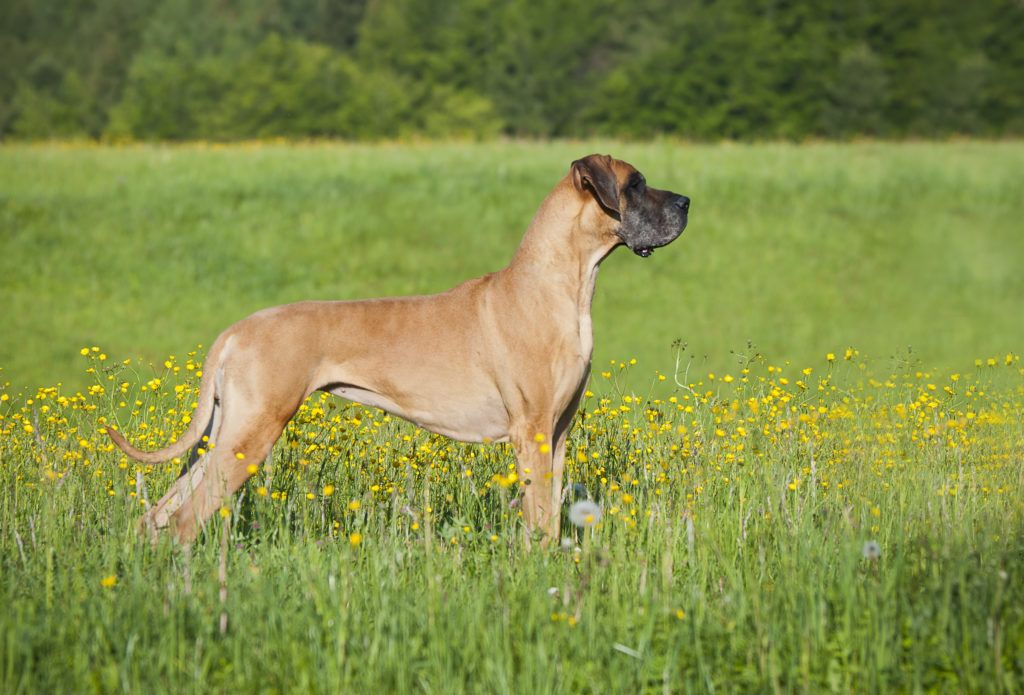
Ridgeback breeders need to be aware of the genetic influences of other breeds, such as the Great Dane, that can slowly chip away at their breeding programs.
Is it any wonder, then, that Ridgeback type can seem so infuriatingly elusive for those who try to pin it down, either in their whelping boxes, or in the show ring? By knowing what influences lie in the genes of our dogs, we can be more aware when they begin to push breed type in the wrong direction, like a sudden current angling a swimmer away from shore. After all, past is always prologue, and knowing where we’ve been helps us immeasurably in determining where to go next.
Calling all Ridgebacks: Drs. Ostrander and Dreger are looking for Ridgebacks from a variety of lines and countries to continue their genetic work. If you are willing to contribute a blood sample for this research, please contact me at denise@ridgebackcentral.com, and I will put you in touch.
The eagle has landed … right on your Ridgeback!
If you’ve been around Ridgebacks a while, you’ve doubtless heard the argument about whether the breed is a Sighthound or not.
Richard and Debbie van Aken think the answer is a resounding yes, and they attribute that conclusion to a rather persnickety species.
Several years ago, the van Akens set up a nesting box for Verreaux’s eagle-owls on their property in South Africa. The largest owl species found in Africa, with a wingspan of more than five feet, eagle-owls are unique among their species for their bright pink eyelids. They are great at killing vermin, and their numbers have dwindled in South Africa, which is why the van Akens thought it would be a great idea to give them their own aerie apartment on the property
It took several years before the box was occupied by its intended residents, but eventually the owls arrived.
And soon after that, the Ridgeback bombing began.
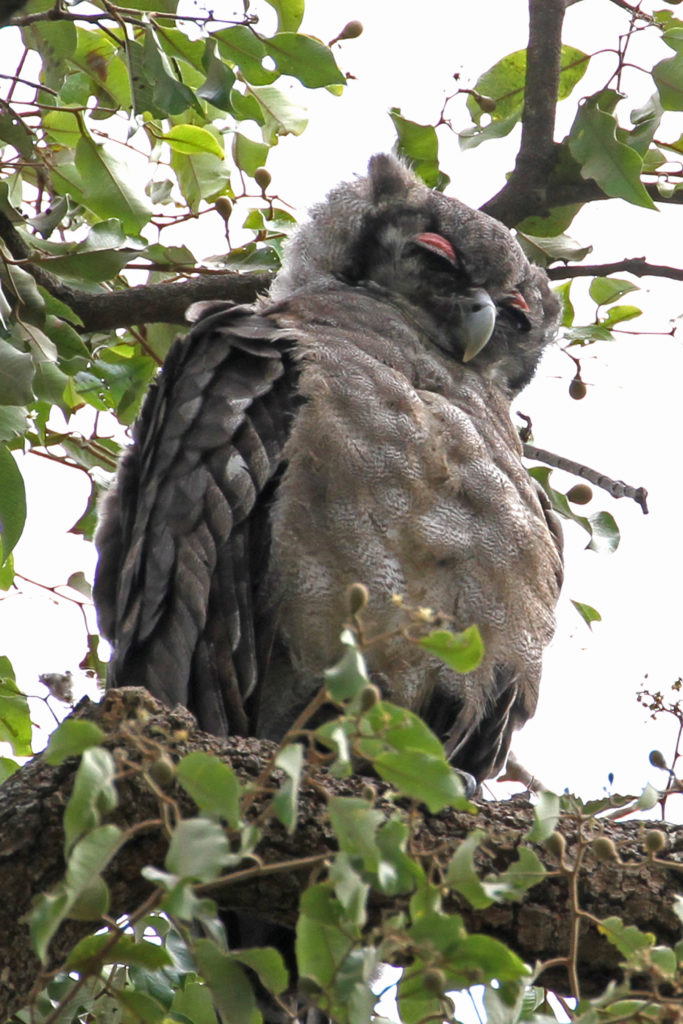
A Verreaux’s eagle-owl. Note the distinctive pink eyelids. Photo by Gisela Gerson Lohman.
Eagle-owls, it turns out, are intensely territorial. And though they are nocturnal hunters, they are also apparently very light sleepers. Roosting in the shaded branches of old trees, these apex predators will swoop down when roused. And apparently, nothing rouses a Verreaux’s eagle-owl quite like a Ridgeback trotting around, minding its own business.
“They attack the dogs silently,” explains Debbie, who took to taking torches on walks to protect their five dogs from these “mean machines” who rule the sky. As for the dogs, “they spot the owls instantly,” she says — a nod to the breed’s tremendous visual capacity. While the eagle-owls will sometimes perch on the outside railings and peer into the house — Debbie is quick to draw the curtains on the feathered peepers — they don’t bother the humans. It’s just the Ridgebacks who’ve ignited this cross-species vendetta.
The eagle-owl attacks on the van Akens’ Ridgebacks were so upsetting that Richard had vowed to dismantle the nesting box. But he needn’t have bothered: Nesting season arrived, and the eagle-owls didn’t. Debbie doesn’t know what happened to them. And while she’s relieved that her dogs can now roam the property without fear of being dive-bombed, she’s sadly nostalgic, too.
“Go figure — now that they are not around to bully the dogs anymore, we miss them,” she says of the Ridgeback-hating flyers.
Do your Ridgebacks have to fend off any kind of wildlife? Have a story of interspecies interaction to share? Email me at denise@ridgebackcentral.com.
What will your Ridgeback be for Halloween?
Halloween is coming, and with it two near certainties:
One, your Ridgeback is going to bark his head off with every ding (or dong) of the doorbell. (Unless you’ve got one of the quiet ones – Ridgebacks, not doorbells, that is. If so, consider yourself blessed!)
And two, you will be tempted — if only for a brief, fleeting moment — to dress him (or her) up in a costume.
Why not just give in to the impulse? And if you’re in need of some inspiration, just read on. Whether store-bought or hand-made, there are lots of costume possibilities for your lovable red dog.
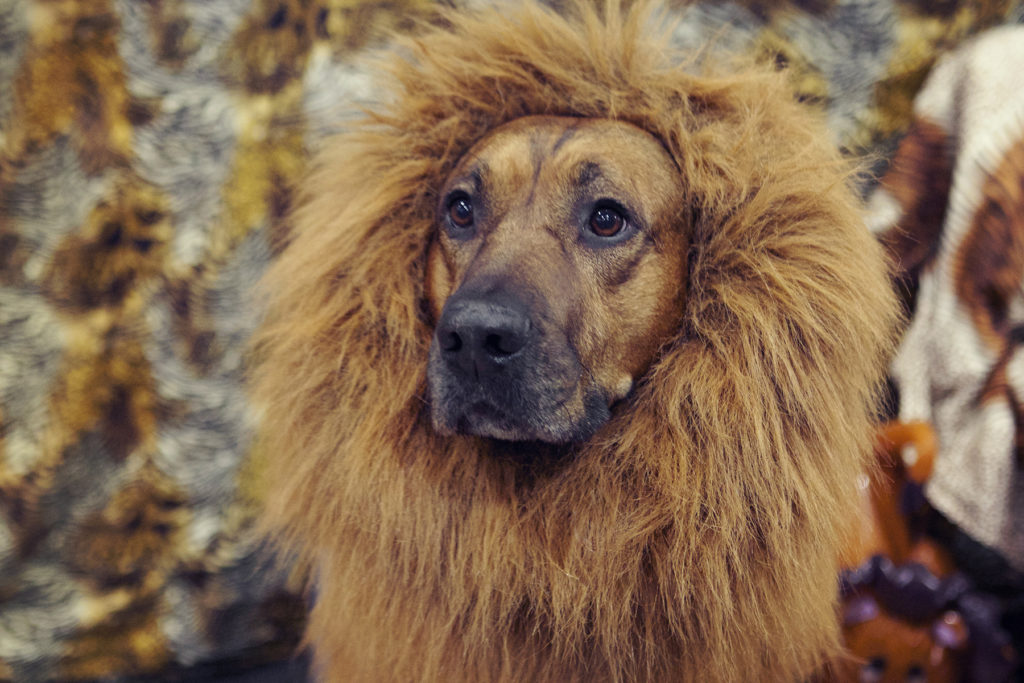
The mane event! Photo by Kristie Lee
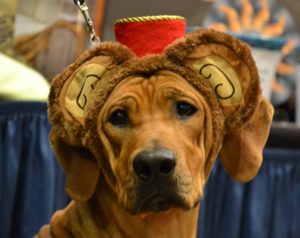
Have you seen my wicked witch? Photo by Bill Kent.
For starters, a popular Ridgeback costume in recent years has been the faux lion mane. Not only is it a not-so-subtle wink at the Ridgeback’s iconic role as a lion hunter – the Ridgeback version of a Dachshund in a hot-dog-bun get-up – but the gold-toned fur matches our dogs’ wheaten coats with eerie precision. The wigs are cheap – less than $20 – and are available on eBay and Amazon, among other places. (Most of the models are, pathetically, Golden Retrievers.)
Arguably the greatest example of come-here-my-pretty Ridgebacks was at the 2013 Rhodesian Ridgeback Club of the United States national specialty in Kansas. The highlight at this annual Ridgeback show is usually the conformation ring, where Ridgebacks strut their stuff for a judge — very serious business. But since that particular year’s show also spanned Halloween, its huge and imposing ring was set aside for one evening to host dozens upon dozens of costumed Ridgebacks. Jockeys, flying monkeys, lobsters, tigers, bumblebees, Minions, even a container of McDonald’s French fries – you name it, our Ridgebacks impersonated it.
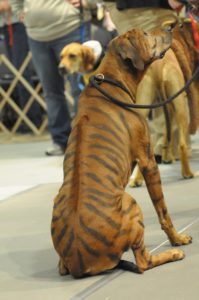
Lions, and tigers, and Ridgebacks, oh my! Photo by Sara Venturelli
Click or tap here to see the parade of dogs, and their equally decked-out handlers. I guarantee you’ve never seen anything like it. (Be sure to adjust your volume!)
The big winner, Margo, kept with the popular Wizard of Oz theme – we were in Kansas, after all – by dressing as the wagon from Professor Marvel, Oz’s alter ego. Margo was in a doggie cart because she was suffering from degenerative myelopathy, a progressive paralysis of the spine that, while not painful, is untreatable. (Today, thanks to a genetic test, breeders are able to avoid producing this disease.) Margo and her owner Charlene Rabinak are proof that any Ridgeback is a candidate for costumes, as long you have a little creativity.
Who needs a ridge, anyway?
Not surprisingly, Ridgeback breed culture has always revolved around the ridge.
Ever since the breed’s name was changed from African Lion Dog to Rhodesian Ridgeback, the message was clear: This native breed of southern Africa was special not because it hunted the king of beasts, but rather for the backward-growing stripe of hair up its back.
Early Ridgeback fanciers in America heard the message loud and clear from their African mentors across the pond: Puppies without ridges were not considered typical of the breed, and were often culled, or euthanized, at birth. (It’s important to remember that 50 years ago, attitudes about companion animals – and their expendability – were significantly different from today.) Thankfully, most modern breeders across the globe see ridgeless puppies for what they are – wonderful, loving pets for the families who are lucky enough to own them.
In this age of tremendous genetic advancement and study, we no longer need a ridge to tell us if a dog is a purebred Ridgeback: His DNA can now tell us.
So that begs the question: Do we need a ridge at all?
I think the answer is yes, for two reasons.
First, the ridge helps the Rhodesian Ridgeback distinguish itself from other athletic, short-coated, red dogs. Some Redbone Coonhounds, for instance, do a very credible Ridgeback impersonation.
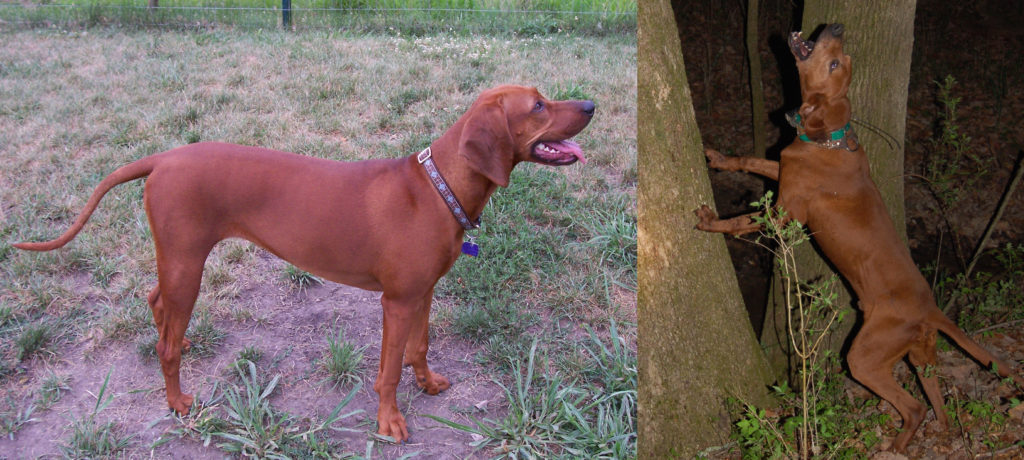
Two Redbone Coonhounds. Couldn’t they be confused for Ridgebacks at first glance?
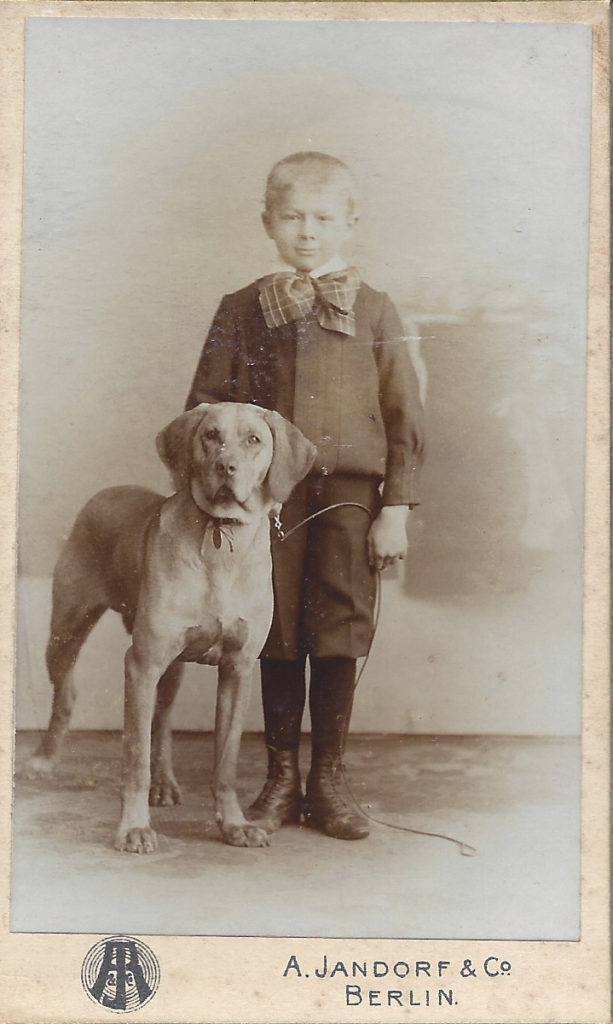
Ridgeback or not? Given the time period — late 19th-Century Germany — likely not.
And take a look at the 19th Century cabinet card at left, which was being sold on eBay as a portrait of a Ridgeback. First of all, there is no historical evidence of Ridgebacks existing in Germany in the 1880s and ’90s, when this photograph was taken; the breed was still in its infancy in southern Africa, and looked very little like the modern breed we know today, which really started to emerge in the 1930s and ’40s.
But if I saw this long-ago dog on the street, I might wonder if he was a brown-nosed Ridgeback – albeit a too-houndy one who had some Labrador Retriever overtones. And I’d check his back for a ridge.
The other reason why we shouldn’t consider the ridge obsolete came up at the Rhodesian Ridgeback World Congress in Sweden over the summer. Geneticist Nicolette Salmon-Hillbertz pointed out that ridges have persisted in the indigenous dogs of southern Africa for millennia, without any interference from humans, and nature doesn’t keep traits around unless they provide some benefit to the animal carrying them. So, she posited, the ridge must be beneficial to Africa dogs – otherwise nature would have long ago extinguished it.
Reinforcing that theory was Helle Lauridsen of Lewanika Ridgebacks in Denmark, who shared this story: When she was living in Western Zambia, working with local craftspeople, she came across a group of refugees from the Angolean war living in the deep roadless bush who had a litter of puppies, all ridged in a wide variety of shapes and places. These ridged puppies were accorded special status: They were well fed and were even permitted to play and sleep inside the dwelling with family members. When Helle asked about buying one of the ridged dogs, she was told most emphatically no: These were very special dogs, the owner explained. Money could buy food for some months, but a good dog could feed a family for years.
Helle takes pains to point out that these villagers had never met a white person before she visited, so they knew of no “myths” surrounding the value of ridged dogs that had come from outside their culture. Rather, their attitude about the value of the ridged dogs was a result of their experience with them for as far back as their oral history extended.
Sometimes there’s more to truth than what can be measured with calipers and yardsticks, so I’m for keeping the ridge, and its mysterious, hidden benefits.
What do you think?
Horsing Around with Ridgebacks
Many years ago, at a dog show in Virginia, I treated myself to a gold pendant of a gaiting Ridgeback. I am fussy about the depictions of the breed that I buy — none of those wrinkled, Mastiff wanna-bes with ridges for me. And this gold-cast Ridgeback was as good as they get, in my opinion.
Recently, I took the piece in to a jeweler and asked him to make up a new bail.”Nice horse,” he said appreciatively.
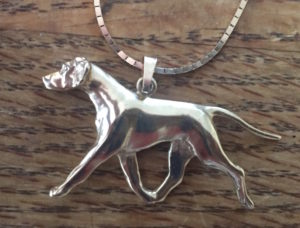
I corrected him, and noted that he wasn’t the first to make that mistake. And it’s understandable: A good Ridgeback should remind of you of a thoroughbred horse — hard muscled but stylish, effortless but powerful in motion.
That analogy was driven home at the 2016 Rhodesian Ridgeback World Congress this June in Lund, Sweden, where British breeder-judge Ann Woodrow did an in-depth presentation comparing the Ridgeback to its equine counterparts. The dog world has its equivalent of quarter horses, she explained. (Think of a stocky galloper like the Bullmastiff.) On the other end of the spectrum are the Arabians, built for sheer speed and beauty, refinement personified. And somewhere in the middle, Ann reminded, is the thoroughbred — and, for that matter, the Ridgeback.
It’s no coincidence, of course, that the modern Ridgeback standard “borrowed” liberally from the Dalmatian standard of the 1940s. Both breeds are endurance trotters, expected to follow a rider on horseback for hours without breaking down or tiring.
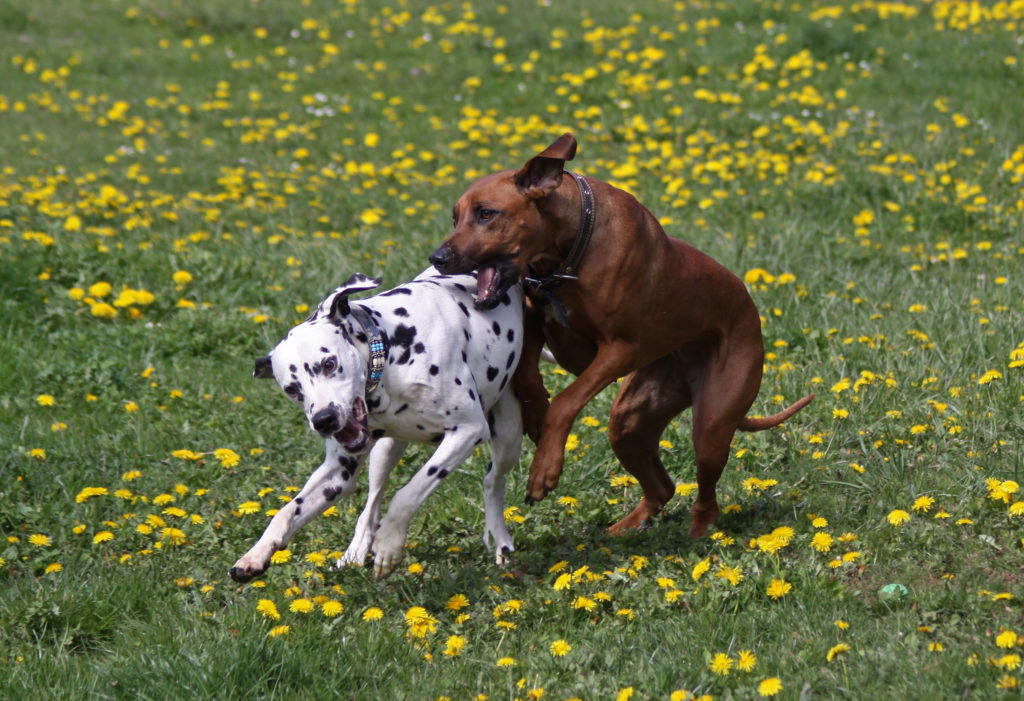
For quite a while now, I’ve been seeing a print of a horse and a Ridgeback popping up on eBay. Painted by Orren Mixer, it features a famous horse, and his not-so-famous Ridgeback companion. The horse, Cutter Bill, born in 1952, was a quarter-horse stallion; as his name suggests, he was a star at the equestrian sport of cutting, a western-style competition in which horse and rider work as a team to demonstrate their athleticism and ability to work cattle. Lep the Ridgeback was Cutter Bill’s stablemate, and their barn in Denton, Texas, is visible in the background of the painting.
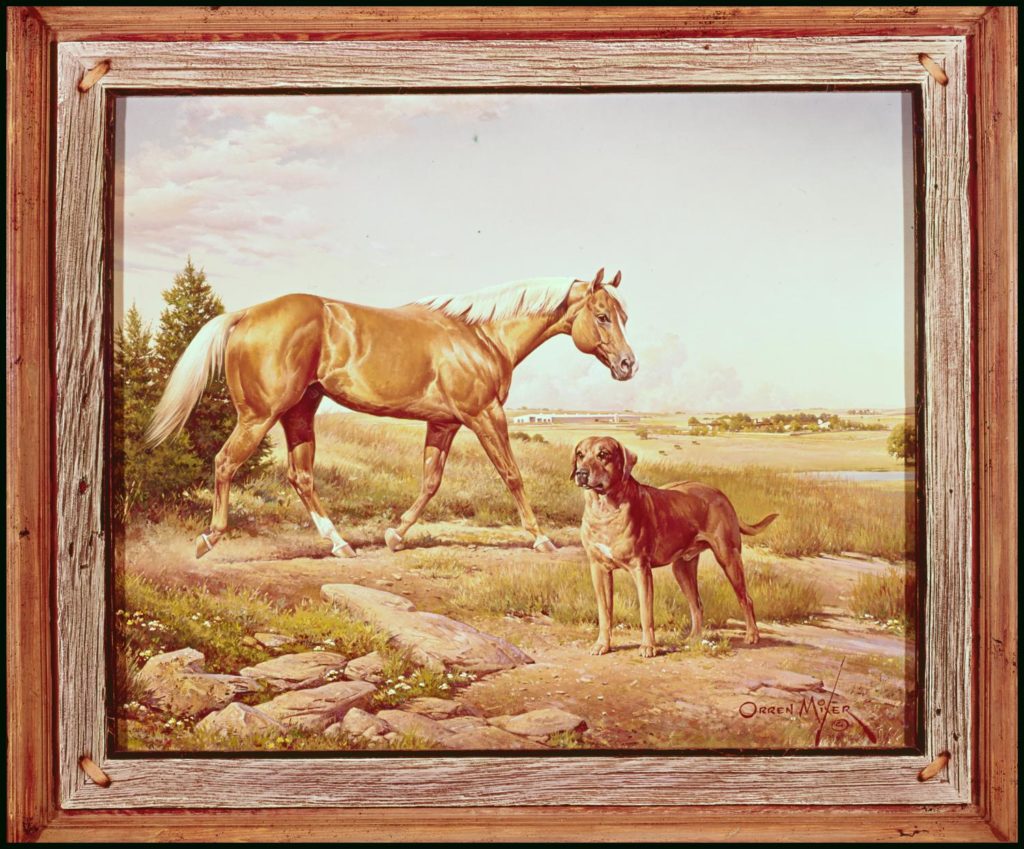
Photo courtesy Horse Country USA Archive
Now, to be honest, Lep is not my style Ridgeback: Like many dogs of his era, he was heavier and more roughly made than the dogs we favor today. In this, he follows Ann’s Ridgeback-to-horse comparison quite neatly, looking more like his quarter-horse companion than the more elegant thoroughbreds on which the ideal template of the breed is based.
Both Cutter Bill and Lep were owned by Rex Cauble, a larger-than-life Texan who was convicted in 1982 on racketeering charges for his involvement with the so-called “Cowboy Mafia” marijuana smugglers. Cauble, who died in 2003, maintaining his innocence all the while, could have a hair-trigger temper: An article in Dallas-based D magazine says that when a ranch employee stumbled over Lep, Rex pistol-whipped him for his carelessness.
The millionaire rancher had another at least one other Ridgeback, but Lep appears to have been his favorite.
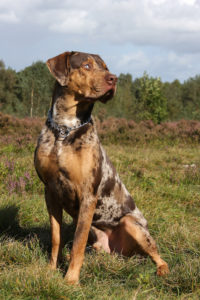
Catahoula Leopard Dog.
Cauble then bred one of them to a “Leopard Cowdog” — presumably, a Catahoula Leopard Dog, which is a hog-hunting cur named after the Louisiana parish where it was developed. As the photo to the left suggests, but for the merle coat, that breed does evoke the Ridgeback more than most others. Which is probably why Lep, who was named for his Catahoula parent and weighed in at 155 pounds, looked like a purebred Ridgeback — except, perhaps, for his size.
“When he lies on the back seat of Cauble’s Cadillac, he covers it, brother, he covers it!” the story gushed.
And that’s quite enough horsing around for today.
Hope for Devastating Form of Epilepsy in Young Ridgebacks
I know last week I promised you another update on the 2016 Rhodesian Ridgeback World Congress – and pinky-promise, that’s coming – but today I want to share a group page that’s really blowing up on Facebook – and for all the right reasons.
Seemingly countless times a day, little pings from my phone and laptop tell me new members are being added to the fledgling Myoclonic epilepsy in rhodesian ridgebacks Facebook page. Last I checked, it was at almost 850 members.
Rhodesian Ridgebacks, like many dog breeds, can develop epilepsy: In the United States, the average age of onset for the breed is relatively late, usually around five years or six of age. But the form of epilepsy this Facebook page is devoted to appears much earlier, as young as six weeks, and as late as 18 months. Compared to “classic” epilepsy, this juvenile form is characterized by frequent muscle jerks or twitches, usually when the dog is sleeping or resting.
Videos of Ridgebacks having these shock-like seizures are quite heartbreaking: The poor dog is jarred and disoriented by the sudden episode, to say nothing of the traumatized owner.
“JME seems to run in many different lines,” explains Nina Lindqvist, founder of the Facebook group and chair of the Ridgeback club of Finland. “Therefore it is assumed that the mutation has already been in the breed for a very, very long time.”
Unfortunately, the long-term prognosis for juvenile myoclonic epilepsy, or JME, in Rhodesian Ridgebacks is not very promising. Dogs can be treated with a variety of anti-convulsive drugs: Levetiracetam (sold under the brand name Keppra in the U.S.), which was developed to treat myoclonic seizures in children, seems to work best, but its efficacy in dogs often cannot be maintained in the long term.
The good news is that European researchers have been busy studying the disorder: In 2015, Andrea Fischer at Munich University in Germany formally identified JME through clinical examinations, and Hannes Lohi’s Koirangeenit group at the University of Helsinki in Finland has isolated the recessive gene responsible for the disease.
Of the 538 samples analyzed by the Finnish researchers, 15 percent were carriers and 4 percent were affected. (And Nina notes that all dogs carrying two copies of the JME gene tested thus far are symptomatic – it appears dogs cannot dodge this genetic bullet.) Though the sampling was very likely skewed in favor of dogs likely to be carriers, the statistics are nonetheless sobering.
Anecdotal evidence suggests that this is a problem more prevalent in Europe and the United Kingdom. There were reportedly no American dogs sampled for the study.
Now that the causal mutation for JME has been identified, breeders are clamoring for a test, which is in the offing, but not until 2017, after the researchers’ studies have been peer reviewed and published.
Later this week, results of dogs tested for the research will be made available on the Ridgeback Club of Finland’s website at www.ridgeback.fi, contingent on the permission of their owners, of course. (There will be a link on the Facebook page, too.) Armed with that information, breeders can avoid breeding dogs with unknown genotypes to confirmed carriers to prevent any new affected dogs from being born.
Once the commercial test is available, Nina stresses that carriers may then be safely bred to confirmed clear dogs to prevent the disease from expressing while maintaining all-important genetic diversity. Remember: Carriers do not have the disease, and can only produce it if bred to another carrier.
Breeders who think they may have inadvertently bred two carriers can contact Nina at nina@lumottu.net. You can also contact her if you have a dog who was tested for JME and wish to have the results made public.
Everyone else, patience and crossed fingers until the commercial test is ready.
The Mysteries of the Ridge, Revealed!
In late June, more than 200 Rhodesian Ridgeback fanciers from across the planet convened in Lund, Sweden, for the 2016 Rhodesian Ridgeback World Congress.
Held every four years, the World Congress is a unique event where the Ridgeback faithful can share views and news, discuss challenges facing the breed, and ignite and rekindle friendships. And last month’s gathering truly raised the bar: Many attendees commented that the line-up of speakers was the among the best of any congress they had attended.
I’d have to agree. Here is just one discussion – I’ll share more in future newsletters – that really set off the lightbulb above my head.
Geneticist Mirko Hornak of the Czech Republic has developed a commercial DNA test that can identify whether a Ridgeback is homozygous or heterozygous for the ridge gene. Other geneticists are offering this service, too, including Jennifer Turner Waldo of the State University of New York at New Palz, who has a DNA test for U.S.-based dogs.
(Quick genetics review: Homozygous dogs, which have two copies of the dominant ridge gene, written in genetic shorthand as RR, can never produce a ridgeless puppy. Heterozygous dogs, which have just one copy of the gene, or Rr, can produce ridgeless if bred to another heterozygote, or a ridgeless. Got it?)
Recently, I’d heard some breeders say that these genetic tests are faulty. Why? Because dogs that were determined to be homozygotes – Ridgebacks that in theory could never produce ridgeless — in fact have produced non-ridged offspring.
Instead, as Mirko and other presenters at the World Congress explained, the ridge mutation, while dominant, has incomplete penetrance. In other words, some dogs may appear to be ridgeless, but are in fact genetically ridged.
In testing Ridgebacks in his lab, Mirko wrote in his abstract for the World Congress, “it was found that sometimes even a dog with one ridge gene (Rr) is ridgeless. This might happen because the ridge gene is very likely silenced,” he posited, adding that no Ridgebacks with two ridge genes (RR) were found to be ridgeless. Mirko estimates that this “silenced” ridge gene occurs in almost 4 percent of puppies produced from homozyogous to heterozygous,or RR x Rr, matings.
This probably explains why persistent oral history in the breed says that ridgeless-to-ridgeless breedings produced ridged offspring. (Even Major Hawley in his landmark book of the breed talks about a Ridgeback being produced from a breeding between ridgeless dogs.) If one of those “ridgeless” dogs was genetically ridged, even though he or she did not have a ridge as we understand the term, then that is indeed possible.
What does this mean for serious students of the breed? We need to understand that it’s not the DNA testing for the ridge gene that’s faulty – it’s our perception of “ridged” that is. While most Ridgeback fanciers understand “ridged” to mean having a very visible stripe of backward-growing hair along the back, genetically “ridged” may mean that just a few hairs are growing against the normal grain of the coat. That follicular disturbance may not be visible to the naked eye, but instead may exist on a molecular level.
(As it happens, I produced one of these “silently ridged” puppies. Click here to see the usual “phantom ridge” that the puppy possessed!)
Curiouser and curiouser! Look for more World Congress views and analysis in upcoming posts …
We Are the World: The Congress is Coming!
The Rhodesian RidgebackWorld Congress is sort of like the Olympics for our breed: Every four years, Ridgebackers from across the world gather for a conference that includes two days of Ridgeback-specific lectures and presentations followed by an official World Congress Dog Show. It’s a rare chance to immerse yourself in Ridgebackdom and meet all the breed’s global “movers and shakers.”
The first Rhodesian Ridgeback World Congress was held, appropriately, in South Africa, in 1984. The latest one is slated for Lund, Sweden, on June 28 to 30, 2016, with more than 200 people registered to attend (including yours truly!). To get a sense of the scope of the events, visit the 2016 RRWC website at www.nordicrrwc.org.
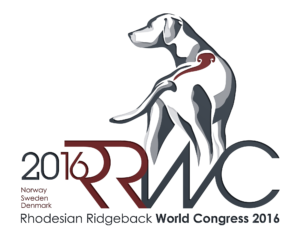
The 2020 World Congress will be held in Germany. And at the end of this year’s Congress, we will vote for the location for 2024. It seems very, very far away, but comes up quicker than you might think!
Here is the complete list of Rhodesian Ridgeback World Congresses to date, and their locations:
1984: Johannesburg, South Africa
1988: Hilleroed, Denmark
1992: Warwickshire, England
1996: Melbourne, Victoria, Australia
2000: Garderen, Netherlands
2004: Dallas, Texas, United States
2008: Portumna, Ireland
2012: Mississauga, Ontario, Canada
2016: Lund, Sweden
2020: Germany
I’ll be posting photos and video from the 2016 World Congress on Facebook and Instagram. Be sure to like and follow us!
The Love That Dares Not Speak (or Is That Purr?) Its Name …
Ridgebacks and big cats are supposed to be natural enemies. But there are a handful of Ridgebacks who have gone against type to become the dedicated companions of … cheetahs.
At the San Diego Zoo Safari Park, a female Ridgeback named Raina has been keeping company with Ruuxa, a cheetah who was rejected by his mother. The two are “ambassadors” for their respective species, and support systems for each other: When Ruuxa had surgery to correct his chondrodysyplasia, in which the forelegs bow abnormally, Raina settled next to him in his crate while he recovered.
The San Diego Safari Park has been pairing cats and canines for three decades, but keepers say the bond Raina and Ruuxa have is the strongest they have ever seen.
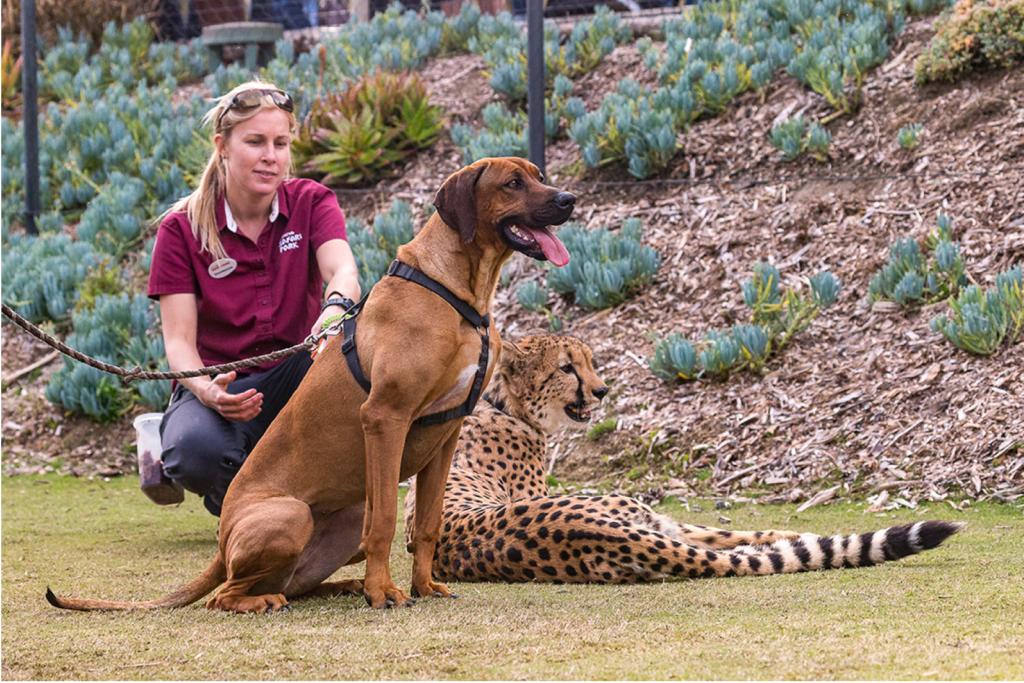
Unlikely bedfellows: Raina the Ridgeback and Ruuxa the cheetah. Photo courtesy San Diego Zoo Safari Park
Meanwhile, this April at Wildlife Safari in Winston, Oregon, a six-week-old Ridgeback puppy named Dayo became the canine companion to a lonely cheetah cub called Pancake. Because, like Raina and Ruuxa, the two were introduced at the optimal time for bonding and imprinting, they are now inseparable, as the National Geographic video below shows.
You might notice that Dayo has a docked tail, which is never done for aesthetic reasons on a Ridgeback; more likely, he had a severe tail kink, which can interfere with the dog’s ability to eliminate unless amputated. And in some very rare cases, Ridgebacks have been born with naturally bobbed tails. (Hmmm … sounds like another blog post coming on!)
Anatomy of a Ridgeback Brain
